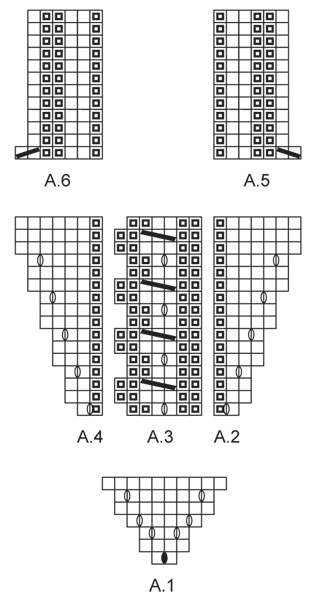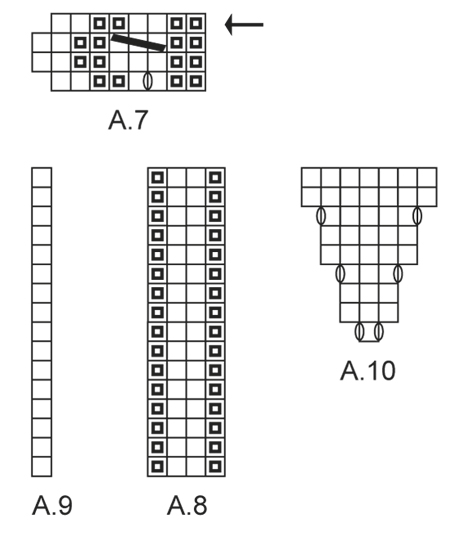Comments / Questions (21)
![]() Andrea wrote:
Andrea wrote:
Can this pattern be easily adapted to straight needle knitting
11.12.2024 - 13:46DROPS Design answered:
Dear Andrea, you can check the following lesson to adjust this pattern to straight needles: https://www.garnstudio.com/lesson.php?id=13&cid=19. However, the shaping of the hat and neck warmer and the high amount of stitches for the neck warmer may make the pieces more difficult to work with straight needles. But you can try it, adjusting the pattern as in the lesson. Happy knitting!
15.12.2024 - 19:22
![]() Charlotte Kristensen wrote:
Charlotte Kristensen wrote:
Jeg strikker hals delen. Jeg skal til udtagninger, men jeg forstår ikke hvordan. Skal jeg strikke efter Diagrram A8, efterfulgt A3, og så A10,A9 og så gentage disse runden rundt? Jeg syntes ikke mønsteret kommer til at passe? Jeg undrer mig nok bare over hvor udtagningerne skal laves/sættes😅
21.10.2022 - 03:17DROPS Design answered:
Hej, Slå 102-119 m op med Cotton Merino på rundp 4. Strik således: * Diag A.8 over 4 m, diag A.3 over 6 m, diag A.9 over 1 m og diag A.3 over 6 m *, gentag disse 17 masker fra *-* omg rundt (6-7 gange) til arb måler ca 10 cm. Du erstatter nu A.9 med A.10 hvor du tager ud i hver side af A.10 med omslag på hver 4.omgang til arbejdet måler 22 cm. Omslagen strikkes ret så der bliver hul...
25.10.2022 - 12:18
![]() Emma wrote:
Emma wrote:
Hei! Ranteenlämmittimien peukaloaukosta: olisiko se syytä aloittaa yhtä riviä aikaisemmin siten, että nurjalla puolella neulottaisiin mallineuleen rivejä 2 ja 4 (pelkkää oikeaa ja nurjaa), oikealla puolella rivejä 1 ja 3?
02.08.2022 - 10:43
![]() GERTRUD wrote:
GERTRUD wrote:
Ich verstehe nicht, wie ich bei den Pulswärmern in hin und Rückreihen strecken soll, ( kraus rechts ?!) wenn ich auf einem Nadelspiel stricke. gleiches gilt für A7. ist es dann nur immer in " Hinreihen" also immer nur so, wie es erscheint?
20.10.2021 - 19:13DROPS Design answered:
Liebe Gertrud, Pulswärmer werden in Runden gestrickt - A.7 zeigt alle Reihen, die stricken Sie alle rechts nach links (keine "Rückreihe" von links/innenseite/Rückseite gestrickt). Dies wird korrigiert, danke für den Hinweis. Viel Spaß beim stricken!
21.10.2021 - 07:02
![]() Maria wrote:
Maria wrote:
I am having the same problem as Pam; when I work A.1 as charted I end up with 45 stitches, and further, the pattern goes off on row 4 of the chart. I worked A.1 as 7 rounds: 1: (k1, yo, k1) 2: (k18) 3:(k1, yo, k2, yo,k1)- 2 sets remain so I k them 4: (k1, yo, k4, yo, k1) 5: k around 6: (k, yo, k6, yo, k1) 7: k around Your answer to Pam suggests to work ONLY the first row of the chart 6 times (that is, for 6 rounds); is that how it should be done?
13.01.2021 - 23:53DROPS Design answered:
Dear Maria, A.1 should be worked a total of 6 times on the round, starting with 6 times 2 sts, then increase on ever other round as shown in diagram - there are 10 sts after last increase round x 6 repeats = 60 sts on needle. After last row in diagram, you then don't work A.1 anymore but work now as ewplained with (A.2, A.3, A.4), repeat from (to) all the round. Happy knitting!
14.01.2021 - 07:48
![]() Chaja wrote:
Chaja wrote:
Bonjour ! Pour les mitaines, dans le tricot en rond sur les aiguilles double pointe, il faut tricoter à l’inverse de ce qui est proposé : les mailles endroit à l’envers et inversement. Mon travail est joli mais ne ressort pas sur un fond de jersey.
07.12.2020 - 15:27DROPS Design answered:
Bonjour Chaja, pour les mitaines, on tricote le diagramme A.7, non pas sur fond de jersey mais ainsi: *2 m env, torsade sur 2/3 mailles, 2 m env, 2 m end*, répétez de *-* tout le tour, ainsi la torsade se trouve placée avec 2 m env de chaque côté et peut bien ressortir. Bon tricot!
07.12.2020 - 16:07
![]() Kristine Asmussen wrote:
Kristine Asmussen wrote:
Hej. Jeg strikker halsdelen. Jeg er nået til udtagningerne. Er det korrekt de ligsom gentages over 3 omgang - mens hulmønsteret gentages over 4 omgange?
21.03.2019 - 06:58DROPS Design answered:
Hei Kristine. Hullmønsteret du ser langs flettene og økningene er det samme diagrammet (diagram A.10). Det økes på hver 3 omgang, altså er hullmønsteret hver 3 omgang. I tillegg er det et flettemønster, med 1 hull mellom hver flette (A.3), og her er hullene på hver 4 omgang. Dette stemmer. God fornøyelse.
26.03.2019 - 13:52
![]() Pam wrote:
Pam wrote:
When working the hat I end up with 45 stitches, not 60. I have tried this twice and still end up with 45. Is this an error in the instructions? If not I don't know what I am doing incorrectly. Any suggestions?
07.07.2017 - 00:50DROPS Design answered:
Dear Pam, you are working A.1 (= 2sts on 1st round) a total of 6 times in the round, and you will inc every other round, when A.1 has been worked, there are 10 sts in each A.1 = 10sts x 6 = 60 sts. Happy knitting!
07.07.2017 - 09:27Emily wrote:
Thank you for the answer. I still don't understand how I should turn the piece and work still the same pattern. It will then be messed up won't it? Sorry I am new to knitting
22.08.2016 - 11:07DROPS Design answered:
Dear Emily, after you have worked the round before the one with the arrow, work the first 3 sts in diagram (= P2, K1), then turn to work from WS (ie you won't work in the round anymore for some rows) and continue as before but now read diagram from the left towards the right on rows from WS starting with P1, K2, then work last row in diagram from the left towards the right and work now alternately from RS (rows with YO and dec) and from WS. Happy knitting!
22.08.2016 - 13:13Emily wrote:
Thank you for the answer. I still don't understand how I should turn the piece and work still the same pattern. It will then be messed up won't it? Sorry I am new to knitting
22.08.2016 - 11:02
Tourmaline#tourmalineset |
||||||||||||||||||||||
|
|
||||||||||||||||||||||
Set consists of: Knitted DROPS hat, wrist warmers and neck warmer with small cables and rib in ”Cotton Merino”.
DROPS 164-39 |
||||||||||||||||||||||
|
GARTER ST (worked in the round): * K 1 round and P 1 round *, repeat from *-*. 1 ridge = 2 rounds. PATTERN HAT: See diagrams A.1 to A.6. PATTERN WRIST WARMER: See diagram A.7. The diagram shows all rows in pattern seen from RS. BIND OFF WITH YOs (applies to wrist warmer): To get a nice finish on wrist warmer bind off with YOs like this with K: * bind off 2 sts, 1 YO, bind off YO, 1 YO, bind off YO, 1 YO, bind off YO *, repeat from *-*. PATTERN NECK WARMER: See diagram A.3, A.8, A9 and A.10. ---------------------------------------------------------- HAT: Worked top down in the round on double pointed needles and then circular needle. Cast on 6 sts evenly on 3 double pointed needle size 4 mm / US 6 with Cotton Merino. Work 2 sts in each st the entire round (work alternately in front and back loop of st) = 12 sts. K 1 round. Insert a marker at the beg of the round. Then work according to diagram A.1 (= 6 repetitions on round). Switch to 4 double pointed needles or circular needle when needed. When diagram has been worked 1 time vertically, there are 60 sts on needle. REMEMBER THE KNITTING GAUGE Now work as follows over A.1: * Work A.2 over 2 sts, A.3 over 6 sts, A.4 over 2 sts *, repeat from *-* the entire round = 6 repetitions on round. When diagram has been worked 1 time vertically, there are 120 sts on needle. Continue to work as last round in A.2 over A.2, work A.3 as before and work as last round in A.4 over A.4 until piece measures 19 cm / 7½'' in total, adjust so that last round is a round without YO. Switch to circular needle size 3.5 mm / US 4 and work A.5 over A.2, work A.3 as before and work A.6 over A.4 = 108 sts. When diagram has been worked 1 time vertically, use double yarn and bind off with K over K and P over P. ---------------------------------------------------------- WRIST WARMERS: Worked in the round on double pointed needles. Cast on 40 sts on double pointed needles size 3.5 mm / US 4 with Cotton Merino. Work 2 ridges in GARTER ST - see explanation above. Then work according to diagram A.7 (= 5 repetitions on round), insert a marker at beg of round. REMEMBER THE KNITTING GAUGE When piece measures approx. 14 cm / 5½'', adjust so that last round is round with arrow in diagram. Work the first 3 sts in diagram (= P 2, K 1; the middle of a cable). Turn piece and work back and forth according to diagram over all sts. Where piece is divided the sts in diagram are worked without YO and without cable. This is thumb gusset. Continue to work back and forth like this until diagram has been worked 3 times vertically. Put piece tog, work in the round as before thumb hole. Work like this until piece measures approx. 20 cm / 8''. Work 2 ridges and BIND OFF WITH YOs - see explanation above. Knit another wrist warmer the same way. ---------------------------------------------------------- NECK WARMER: Worked in the round on circular needle, top down. Cast on 102-119 sts on circular needle size 4 mm / US 6 with Cotton Merino. Work as follows: * Diagram A.8 over 4 sts, diagram A.3 over 6 sts, diagram A.9 over 1 st and diagram A.3 over 6 sts *, repeat from *-* the entire round until piece measures approx. 10 cm / 4''. REMEMBER THE KNITTING GAUGE Then work pattern as before over A.8 and A.3 but work according to A.10 over A.9. K YOs on next round to make holes. Continue to work pattern as before and inc as shown in A.10 until piece measures 22 cm / 8 3/4'' in total. K 2 rounds, P 1 round and K 1 round. P and loosely bind off on next round. |
||||||||||||||||||||||
Diagram explanations |
||||||||||||||||||||||
|
||||||||||||||||||||||

|
||||||||||||||||||||||

|
||||||||||||||||||||||
Have you finished this pattern?Tag your pictures with #dropspattern #tourmalineset or submit them to the #dropsfan gallery. Do you need help with this pattern?You'll find 26 tutorial videos, a Comments/Questions area and more by visiting the pattern on garnstudio.com. © 1982-2025 DROPS Design A/S. We reserve all rights. This document, including all its sub-sections, has copyrights. Read more about what you can do with our patterns at the bottom of each pattern on our site. |
||||||||||||||||||||||




































































Post a comment to pattern DROPS 164-39
We would love to hear what you have to say about this pattern!
If you want to leave a question, please make sure you select the correct category in the form below, to speed up the answering process. Required fields are marked *.